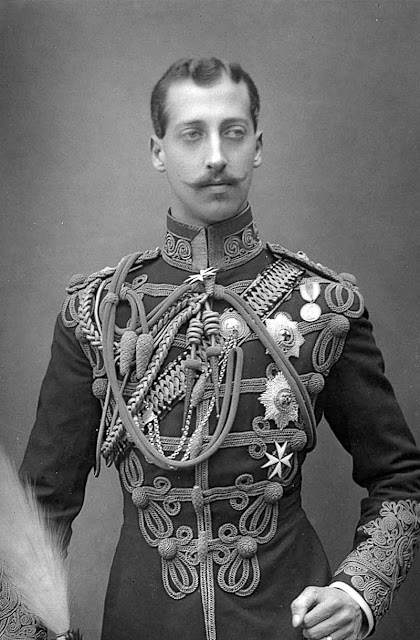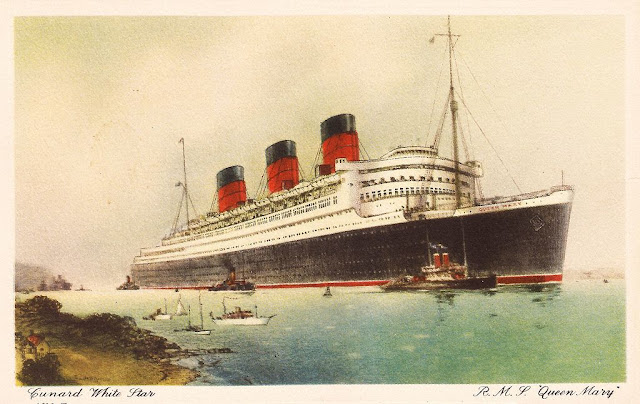---------oOo---------
Following on from yesterday’s post about the death of King George V (1865-1936), here are facts about his life that are of interest (at least, they were to me) . . .
---------oOo---------
An heir and a spare:
An heir and a spare, despite Harry’s whingeing about it, has been part of British royal life since Prince John. With mortality rates high in the early days, spare figures in the line of succession maximised the continuation of the lineage and the power of the royal family.
George was a second son and not meant to become king, the first born of his father Edward VII being the Prince of Wales, Prince Albert Victor, the Duke of Clarence.
King Edward VII (1841 – 1910)
Prince Albert Victor, Duke of Clarence (1864-1892)
Albert fell ill with influenza in the pandemic of 1889–1892. He developed pneumonia and died less than a week after his 28th birthday.
Although Albert had been much loved by the British public and by his brother George, it was George as the spare who would now be heir to the throne.
---------oOo---------
St Edward’s Crown:
St Edward's Crown is the centrepiece of the Crown Jewels of the United Kingdom. Named after Saint Edward the Confessor, versions of it have traditionally been used to crown English and British monarchs at their coronations since the 13th century.
The original crown was a holy relic kept at Westminster Abbey, Edward's burial place, until the regalia were either sold or melted down when Parliament abolished the monarchy in 1649, during the English Civil War.
The current St Edward's Crown was made for Charles II in 1661. It is 22-carat gold, 30 centimetres (12 in) tall, weighs 2.23 kilograms (4.9 lb), and is decorated with 444 precious and fine gemstones. The crown is similar in weight and overall appearance to the original.
After 1689, it was not used to crown any monarch for over 200 years. In 1911, the tradition was revived by George V and has continued ever since, including at the 2023 Coronation of Charles III and Camilla.
---------oOo---------
Princess Mary:
When the names were being handed out, Mary must have been at the head of the queue, her name was Victoria Mary Augusta Louise Olga Pauline Claudine Agness. She was generally known as Princess Mary. By birth, Mary was a member of the House of Teck in Berlin, Germany, and through her mother, she was a distant member of the British Royal Family
Mary had been engaged to marry Prince Albert Victor, but his death six weeks before their wedding put a damper on that. Queen Victoria still favoured Mary as a royal bride and therefore arranged for her to marry Albert Victor's brother, Prince George. Reports are that their marriage was a happy one, evidenced by their having six kids together, and, unlike his father, George never taking a mistress.
Mary of Teck, Queen of the United Kingdom and Empress of India as the wife of George V. Before his accession, she was successively Duchess of York, Duchess of Cornwall and Princess of Wales.
---------oOo---------
Queen Mary:
In 1934 the Cunard Line and the White Star Line merged.
One of the issues that had to be resolved was naming of future ships. Cunard had a tradition of naming its ships with names that ended in “ia”, such as Lusitania, Mauretania and Aquitania. The White Star Line, on the other hand, had a tradition of ending its ships’ names with "ic", as in Olympic, Britannic and the ill-fated Titanic. Because Cunard had acquired the White Star Line, many considered that the Cunard tradition would prevail. Others felt it would be appropriate to commence a new naming tradition.
White Star and Cunard continued to separately build ships. White Star built a new ocean liner, Oceanic, and Cunard built two unnamed liners, Ships 534 and 552.
Cunard had kept the proposed name of Ship 534 a closely guarded secret. In 1936 a delegation led by Sir Ashley Sparks, then Chairman of Cunard Line's American offices, approached King George V for permission to name the ship Queen Victoria. Sir Ashley told King George that the company wanted to name the ship after "the greatest of all English queens." Upon hearing this, the king replied, "Oh, my wife will be pleased."
The delegation had no option but to name Ship 534 Queen Mary. Ship 552 became Queen Elizabeth.
Today the Queen Mary is permanently moored as a tourist attraction, hotel, museum and event facility in Long Beach, California
Postcard of the Cunard White Star RMS "Queen Mary"
---------oOo---------
The above pictures are of King George V, Kaiser Wilhelm II and Czar Nicholas II, world leaders going into WW1. The similarity in appearance is because they were all cousins whose grandmother was Queen Victoria. It has been argued by some historians that had Victoria still been alive, the war might not have taken place.
---------oOo---------
George was reputedly an active reader and was said to read a book per week. However, during his reign, he made only four trips outside of the United Kingdom: to India, France, Belgium, and Italy.
"I see in The Times today," George V's private secretary remarked one day, "some damn fool has given fourteen hundred pounds for a single stamp at a private sale." "Yes," the king replied, "I am that damn fool." [George V was in fact an avid collector of postage stamps.]
---------oOo---------
Long before Charles’ limiting of the use of royal title, Queen Victoria had pruned the use of HRH (His/Her Royal Highness) to direct members of the Royal Family. George restricted it even further to children and grandchildren of the monarch. He also did away with numerous other stylings such as “Serene Highness” and simply “Highness.”
---------oOo---------
One day King George V and Queen Mary visited George Cadbury's chocolate factory. Cadbury gallantly led the way with the queen while his wife walked behind with the king. Despite the cold weather, Cadbury removed his hat as a mark of respect for his royal guests. Queen Mary, however, concerned about his health, begged him to be sensible: "Mr. Cadbury, please put on your hat," she beseeched. When he demurred, she repeated her request: "Please, Mr. Cadbury—or I'll ask the king to command you to do so!" Still he demurred... Finally, from behind them came the booming voice of Elizabeth Cadbury: "George, put your hat on!" [He did.]
---------oOo---------
Nein:
Before 1917, members of the British Royal Family had no surname, but only the name of the house or dynasty to which they belonged. Kings and princes were historically known by the names of the countries over which they and their families ruled. Kings and queens therefore signed themselves by their first names only, a tradition in the United Kingdom which has continued to the present day.
The names of dynasties tended to change when the line of succession was taken by a rival faction within the family (for example, Henry IV and the Lancastrians, Edward IV and the Yorkists, Henry VII and the Tudors), or when succession passed to a different family branch through females (for example, Henry II and the Angevins, James I and the Stuarts, George I and the Hanoverians).
Just as children can take their surnames from their father, so sovereigns normally take the name of their 'House' from their father. For this reason, Queen Victoria's eldest son Edward VII belonged to the House of Saxe-Coburg-Gotha (the family name of his father Prince Albert). Edward VII's second son, the spare, George V, became the second king of that dynasty when he succeeded to the throne in 1910.
The outbreak of World War I in 1914 turned public opinion against all things German. George changed the family name from Saxe-Coburg and Gotha to Windsor
had been part of the British dynasty of Saxe-Coburg and Gotha, as were his parents and grandparents, but changed the family name to Windsor, after the Castle of the same name.
At a meeting of the Privy Council on 17 July 1917, George V declared that 'all descendants in the male line of Queen Victoria, who are subjects of these realms, other than female descendants who marry or who have married, shall bear the name of Windsor'.
“A good riddance”, Punch, 1917
---------oOo---------
Political conflicts between the House of Lords and the House of Commons created a constitutional crisis in 1910 that George inherited when he became king. George promised to support reform if the Liberal Party won a clear victory. After they did just that, he gave his support to the 1911 Parliament Act which greatly reduced the power of the House of Lords and made the Commons the more powerful of the two. When the Lords objected to this, George threatened to create 250 Liberal peers to dominate the chamber. The Conservative majority in the House of Lords then had little choice but to let the bill pass.
---------oOo---------
One day Lord Derby delicately suggested that George V be slightly more lenient with his son Edward (the young Prince of Wales). "My father [Edward VII] was frightened of his mother," the king replied, "I was frightened of my father; and I am damned well going to see to it that my children are frightened of me."
---------oOo---------
Radio announcer John Reed King once recalled the day a colleague, Charles Harlington, made a royal blooper. "They sent him into the studio the day George the fifth of England died. And he went on the air and said, 'Ladies and gentlemen, we interrupt this coast-to-coast broadcast to bring you a bulletin from London, England: George the vee is dead.'"









No comments:
Post a Comment
Note: Only a member of this blog may post a comment.